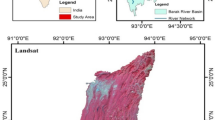Abstract
Total Maximum Daily Load (TMDL) system in Korea is a system that manages the discharge load per unit watershed to achieve the water quality target under the conditions of the six month flow (Q275) and the low water discharge (Q185). However, since the flow conditions of water quality are various in each unit watershed, it is necessary to understand the effect of improving the water quality by flow duration analysis in order to operate an effective TMDL. In this study, the HSPF model was operated by the flow and TP after calibration and verification, and the Low Duration Curve (LDC) was created using simulation results. LDC was used to calculate the excess rate of the water quality target for each flow condition. The scenario to install the artificial wetland was applied to the model for the water quality target and the achievement of the water quality target by the flow duration analysis was evaluated. In addition, the management system of TMDL in Korea would be developed more scientifically by suggesting the allocation load considering the baseline discharge and the safety discharge so that the water quality target can be achieved by the flow duration analysis in the study area.
Similar content being viewed by others
References
Cleland, B. R. (2002). “TMDL Development from the “Bottom Up”–Part II: Using duration curves to connect the pieces.” In: National TMDL Science and Policy 2002–WEF Specialty Conference, Water Environment Federation, Phoenix, Arizona.
Cleland, B. R. (2003). “TMDL Development from the “Bottom up”-Part III: Duration Curve and Wet Weather Assessment.” National TMDL Science and Policy 2003-WEF Specialty Conference, Chicago, IL.
Choi, K. W. (2012). Characteristics of Seasonal Pollutant Load and Application of Load Duration Curve in Jungnang Stream, Master’s Thesis, Gangwon National University, Korea.
Donigian, A. S. (2000). “HSPF Training Workshop Handbook and CD. Lecture #19, Calibration and Verification Issues, Slide #L19-22.” EPA, Washington Information Center, Presented and prepared for U.S. EPA, Office of Water, Office of Science and Technology.
Han, S. H., Shin, H. S., and Kim, S. D. (2007). “Applicability of load duration curve to nakdong river watershed management.” Journal of Korean Society on Water Environment, Vol. 23, No. 5, pp. 620–627.
Hwang, H. S., Kim, S. S., Kim, J. L., and Park, B. K. (2012). “Research on the evaluation of impaired waterbody using the flowrate group at TMDL unit watershed in Nakdong river basin.” Journal of Korean Society on Water Environment, Vol. 28, No. 6, pp. 933–942.
Hwang, H. S., Park, B. K., Kim, Y. S., Park, K. J., Cheon, S. U., and Lee, S. J. (2011) “Research on the applicability of the load duration curve to evaluate the achievement of target water quality in the unit watershed for a TMDL.” Journal of Korean Society on Water Environment, Vol. 27, No. 6, pp. 885–895.
Kim, J. G. (2009). “Development of Web-based Load Duration Curve System for Analysis of TMDL and Water Quality Characteristics in Waterbody.” Master’s Thesis, Gangwon National University, Korea.
Lee, E. J. (2013). Application of total water load management system using watershed model and load duration curves, Ph.D. Dissertation, Cheongju University, Korea.
Ministry of Environment (MOE) in Korea (20l0). White Paper, Advantages and Disadvantages of Using Load Duration Curves to Estimate Existing and Allowable Loads for the Development of Nutrient TMDLs. Ministry of Environment (MOE) in Korea (2011). Total Water Load Management System
NDEP (2003). “Load duration curve methodology for assessment and TMDL.” Development Nevada Division of Environmental Protection.
Park, J. D. and Oh, S. Y. (2012). “Methodology for the identification of impaired waters using LDC for the management of total maximum daily loads.” Journal of Korean Society on Water Environment, Vol. 28, No. 5, pp. 693–703.
Park, J. H. (2010). A study of waterbody health diagnosis method, Master’s Thesis, Kyungpook National University, Korea.
Shin, K. Y. (2013). Development and assessment of load duration curve for total water pollution loading system, Ph.D. Dissertation, Gangwon National University, Korea. U. S.
EPA (2001). Exercise 14-Modeling Alternative scenarios, BMPs, and TMDLs, BASINS/HSPF Training. U. S.
EPA (2007). An Approach for Using Load Duration Curves in the Development of TMDLs.
Wang, C. G., Gu, J. Y., Seo, J. W., Sung, N. C., Shin, J. K., and Lee, Y. H. (2000). Statistical Analysis of Water Quality Data, Donghwa Publisher.
Yoon, C. G., Han, J. Y., Jung, G. W., and Jang, J. H. (2007). “Application of BASINS/WinHSPF for pollutant loading estimation in soyang dam watershed.” Jounral of Korean Society of Limnology, Vol. 40, No. 2, pp. 201–213.
Author information
Authors and Affiliations
Corresponding author
Rights and permissions
About this article
Cite this article
Lee, E.J., Kim, T.G. & Choi, Ks. A Study of the Load Allocation using Watershed Model and Load Duration Curve in TMDL. KSCE J Civ Eng 22, 3222–3232 (2018). https://doi.org/10.1007/s12205-018-0910-0
Received:
Accepted:
Published:
Issue Date:
DOI: https://doi.org/10.1007/s12205-018-0910-0




